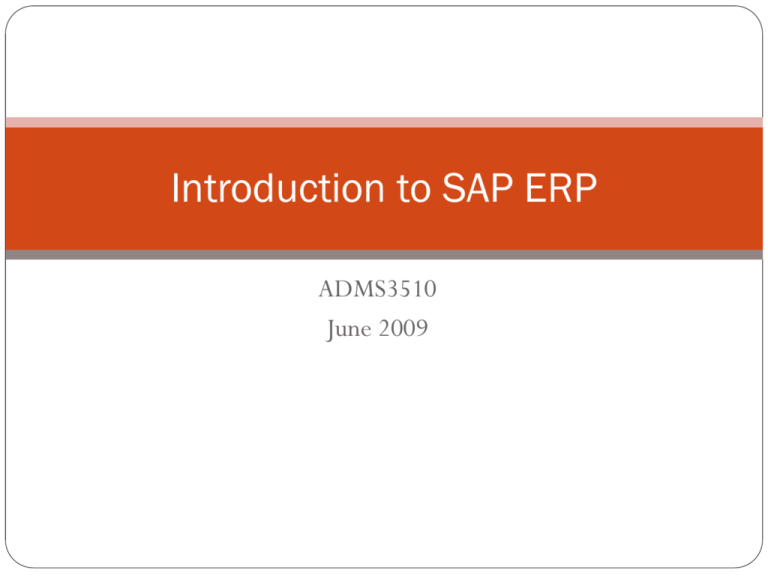
Introduction to SAP ERP
ADMS3510
June 2009
ERP
What are Enterprise Resource Planning (ERP) Systems?
Incredibly large, extensive software packages used to manage a
firm’s business processes.
Standard software packages that must be configured to meet the
needs of a company
Database programs with the following functions:
Input
Storage/Retrieval
Manipulation
Output
2
© 2008 by SAP AG. All rights reserved.
28,610+ Tables in SAP
ERP
Who are the big ERP vendors?
SAP, the German juggernaut
Systeme, Anwendungen, Produkte in der Datenverarbeitung, or
Systems, Analysis and Products in Data Processing.
Don’t be a sap!
Oracle/PeopleSoft/J. D. Edwards (J.D. Orisoft)
Microsoft Great Plains, aimed at smaller companies
SAP Business One is competing product
3
© 2008 by SAP AG. All rights reserved.
SAP R/3 Enterprise
FI
Financial
Accounting
Workflow
QM
PS
PM
Quality
Mgmt.
Project
System
Plant
Maint.
PP
SD
MM
Prod.
Planning
Sales &
Distrib.
Materials
Mgmt.
HR
AM
Human
Resources
Asset
Mgmt.
CO
4
© 2008 by SAP AG. All rights reserved.
Controlling
SAP R/3 Enterprise
SAP can use a
number of
database programs
to actually store
the data.
Oracle
DB2
MSSQL
5
© 2008 by SAP AG. All rights reserved.
Configuration
Configuration is the process of making standard software
fit your business. SAP, as an example, has:
Over 8000 configuration decisions
Data structuring
Sales divisions, distribution channels
Rewriting Code (Modifications)
Not recommended because of compatibility problems when updated
versions of the software are installed.
Customization
Writing code at SAP-specified user exits
Third-party software solutions
6
© 2008 by SAP AG. All rights reserved.
A typical manufacturing company
CO
Calendars
Currencies
FI
Inputs
Manufacturing
Process
Vendor
Master
Material
Master
© 2008 by SAP AG. All rights reserved.
Cust.
Master
Pricing
Pricing
7
Outputs
Basic
Data
Three-tier Client/Server Architecture
USER PCs
Application
Server
USER PCs
Database
Server
Application
Server
8
Application
Server
© 2008 by SAP AG. All rights reserved.
Application
Server
Two-tier Client/Server Architecture
(configuration typical for training)
Database and
Application
Server
User PCs
9
© 2008 by SAP AG. All rights reserved.
SAP vs MS Office
Database and
Application
Server
Nothing is saved on your PC. Only things saved on our
server in Missouri are saved, and they are saved for good.
10
© 2008 by SAP AG. All rights reserved.
Saving in Windows vs SAP
In Window Applications, you save often
so you don’t lose everything when you
get the Blue Screen of Death:
11
© 2008 by SAP AG. All rights reserved.
Saving in Windows vs SAP ...2
In SAP, there are very few delete
options:
Don’t save if things don’t look 100%
correct! Exit the transaction and start
over
12
© 2008 by SAP AG. All rights reserved.
Clients in SAP R/3
What is a client?
A way to separate data in the system
In some ways, a separate database
Also, a table entry
Column (attribute)
Mandt
Client
Row
(Record)
201
201
201
202
202
13
© 2008 by SAP AG. All rights reserved.
Field
Client setup for a hypothetical company
SAP 5 Server
Client 501
14
Client 502
Client 503
01 Fitter Snacker
01 Fitter Snacker
01 Fitter Snacker
02 Fitter Snacker
02 Fitter Snacker
02 Fitter Snacker
03 Fitter Snacker
03 Fitter Snacker
03 Fitter Snacker
99 Fitter Snacker
99 Fitter Snacker
99 Fitter Snacker
© 2008 by SAP AG. All rights reserved.
Data Set Number (##)
I am data set number 00, not you!
Enter Cred. Contr. area ##CR
and Currency USD
15
© 2008 by SAP AG. All rights reserved.
System landscape for student use
501
FS Student
201
Config.
16
502
FS Student
202
CATT Test
© 2008 by SAP AG. All rights reserved.
503
FS Student
203
FS Master
Logging On – SAP GUI
To log on to an R/3 system with the SAP Gui, you need
the proprietary SAP Gui (Graphical User Interface)
software loaded on your system and an internet
connection
Internet Connection
Account on
SAP R/3 System
at hosting site
17
© 2008 by SAP AG. All rights reserved.
PC with SAP Gui
SAP GUI Configuration
First, you need to tell the SAP Gui which system you
want to log into:
If you don’t have
any systems defined,
click on New Item
18
© 2008 by SAP AG. All rights reserved.
System Definition (provided by UCC)
Text description (free)
Address of system (e.g.
sapd.umsystem.edu)
SAP Router usually
not required
System ID
Logical name of system
System Number
Frequently 00, but not always
19
© 2008 by SAP AG. All rights reserved.
R/3 System Selected
Configured SAP Gui
Select System:
double-click or
Logon button
20
© 2008 by SAP AG. All rights reserved.
Logging On
Enter Client
Enter User (R/3 Account)
Enter Password (R/3 Account)
Don’t worry about language—
English will default in
21
© 2008 by SAP AG. All rights reserved.
SAP User-IDs and Passwords
SAPGUI - System ID
IS4
SAPGUI - Description
IS4 -SAP ERP 2005 (6.0)
SAPGUI - Application Server sbasap72.sba.uwm.edu
SAPGUI - System Number
00
Client Number
225
Student Userids
... Will be advised
Student Passwords
(case sensitive)
... Will be advised
Logging On ...2
On the first time logging in to
a new account, you will have
to change the password—try
To remember your new
Password WITHOUT WRITING
IT DOWN!
Then a message or two
Then . . . .
23
© 2008 by SAP AG. All rights reserved.
Success !!
SAP Easy Access
•Master Data Entry
•Transaction Data Entry
24
© 2008 by SAP AG. All rights reserved.
Implementation Guide (IMG)
Where Configuration
Takes Place
25
© 2008 by SAP AG. All rights reserved.
Data Types
Master Data
Data that is relatively stable
Materials, Customers, Vendors
Transaction Data
Data that is relatively temporary
Stored at various stages of a business process
Customer orders, purchase orders, production orders, customer payments
26
© 2008 by SAP AG. All rights reserved.
Transaction Data
Transactions flow down
the river of time
27
© 2008 by SAP AG. All rights reserved.








